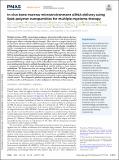In vivo bone marrow microenvironment siRNA delivery using lipid–polymer nanoparticles for multiple myeloma therapy
Author(s)
Guimarães, Pedro PG; Figueroa-Espada, Christian G; Riley, Rachel S; Gong, Ningqiang; Xue, Lulu; Sewastianik, Tomasz; Dennis, Peter S; Loebel, Claudia; Chung, Amanda; Shepherd, Sarah J; Haley, Rebecca M; Hamilton, Alex G; El-Mayta, Rakan; Wang, Karin; Langer, Robert; Anderson, Daniel G; Carrasco, Ruben D; Mitchell, Michael J; ... Show more Show less
DownloadPublished version (9.919Mb)
Publisher with Creative Commons License
Publisher with Creative Commons License
Creative Commons Attribution
Terms of use
Metadata
Show full item recordAbstract
Multiple myeloma (MM), a hematologic malignancy that preferentially colonizes the bone marrow, remains incurable with a survival rate of 3 to 6 mo for those with advanced disease despite great efforts to develop effective therapies. Thus, there is an urgent clinical need for innovative and more effective MM therapeutics. Insights suggest that endothelial cells within the bone marrow microenvironment play a critical role. Specifically, cyclophilin A (CyPA), a homing factor secreted by bone marrow endothelial cells (BMECs), is critical to MM homing, progression, survival, and chemotherapeutic resistance. Thus, inhibition of CyPA provides a potential strategy to simultaneously inhibit MM progression and sensitize MM to chemotherapeutics, improving therapeutic response. However, inhibiting factors from the bone marrow endothelium remains challenging due to delivery barriers. Here, we utilize both RNA interference (RNAi) and lipid–polymer nanoparticles to engineer a potential MM therapy, which targets CyPA within blood vessels of the bone marrow. We used combinatorial chemistry and high-throughput in vivo screening methods to engineer a nanoparticle platform for small interfering RNA (siRNA) delivery to bone marrow endothelium. We demonstrate that our strategy inhibits CyPA in BMECs, preventing MM cell extravasation in vitro. Finally, we show that siRNA-based silencing of CyPA in a murine xenograft model of MM, either alone or in combination with the Food and Drug Administration (FDA)-approved MM therapeutic bortezomib, reduces tumor burden and extends survival. This nanoparticle platform may provide a broadly enabling technology to deliver nucleic acid therapeutics to other malignancies that home to bone marrow.
Date issued
2023-06-20Department
Massachusetts Institute of Technology. Department of Chemical Engineering; Koch Institute for Integrative Cancer Research at MIT; Massachusetts Institute of Technology. Institute for Medical Engineering & ScienceJournal
Proceedings of the National Academy of Sciences
Publisher
Proceedings of the National Academy of Sciences
Citation
Guimarães, Pedro PG, Figueroa-Espada, Christian G, Riley, Rachel S, Gong, Ningqiang, Xue, Lulu et al. 2023. "In vivo bone marrow microenvironment siRNA delivery using lipid–polymer nanoparticles for multiple myeloma therapy." Proceedings of the National Academy of Sciences, 120 (25).
Version: Final published version